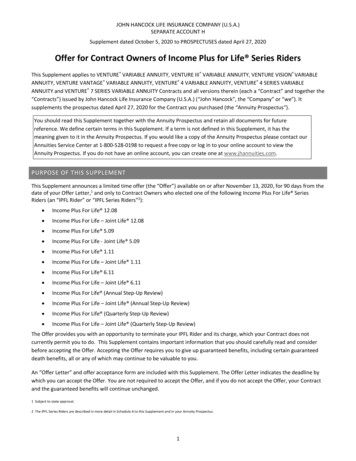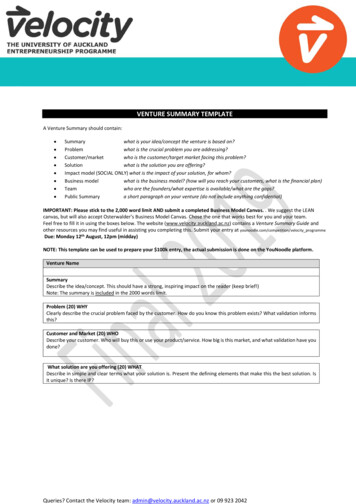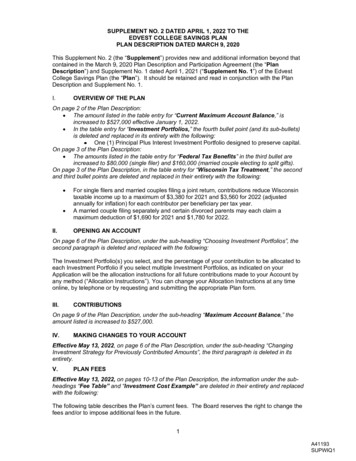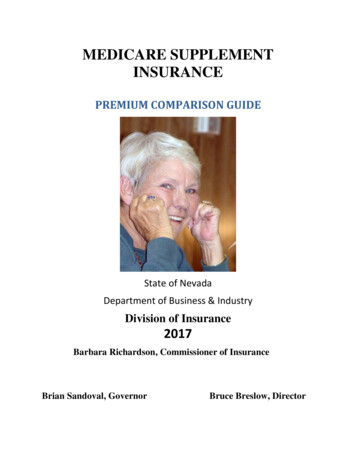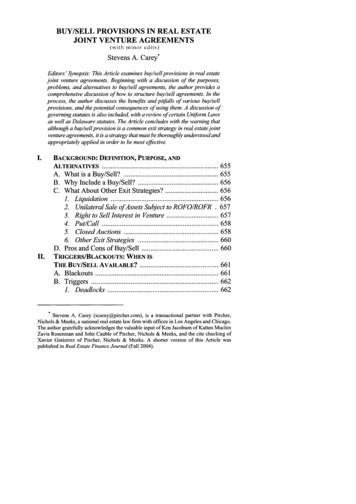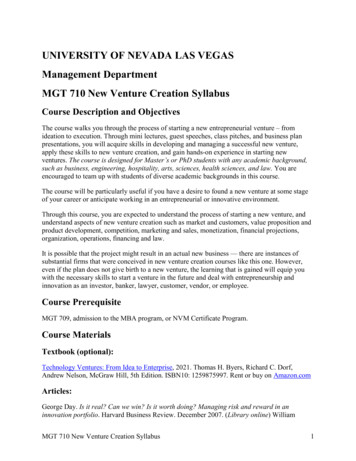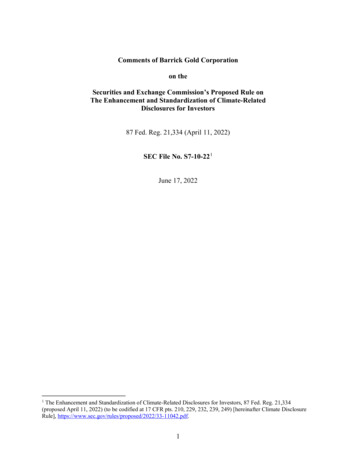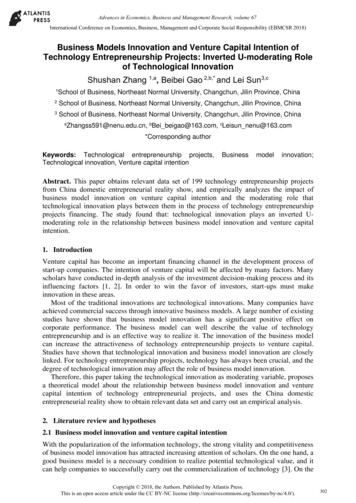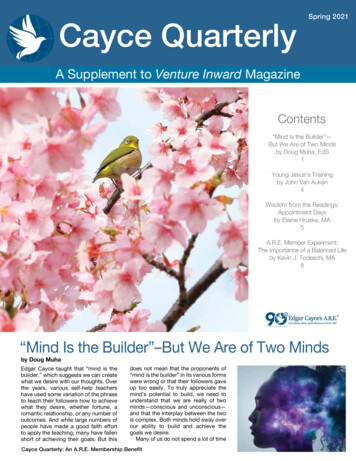
Transcription
Spring 2021Cayce QuarterlyA Supplement to Venture Inward MagazineContents“Mind Is the Builder”—But We Are of Two Mindsby Doug Muha, EdS1Young Jesus’s Trainingby John Van Auken4Wisdom from the Readings:Appointment Daysby Elaine Hruska, MA5A.R.E. Member Experiment:The Importance of a Balanced Lifeby Kevin J. Todeschi, MA8“Mind Is the Builder”–But We Are of Two Mindsby Doug MuhaEdgar Cayce taught that “mind is thebuilder,” which suggests we can createwhat we desire with our thoughts. Overthe years, various self-help teachershave used some variation of the phraseto teach their followers how to achievewhat they desire, whether fortune, aromantic relationship, or any number ofoutcomes. And while large numbers ofpeople have made a good faith effortto apply the teaching, many have fallenshort of achieving their goals. But thisdoes not mean that the proponents of“mind is the builder” in its various formswere wrong or that their followers gaveup too easily. To truly appreciate themind’s potential to build, we need tounderstand that we are really of twominds—conscious and unconscious—and that the interplay between the twois complex. Both minds hold sway overour ability to build and achieve thegoals we desire.Many of us do not spend a lot of timeCayce Quarterly: An A.R.E. Membership BenefitSpring 2021 1
thinking about the unconscious, since by definition it is out ofour conscious awareness. For some time, a natural assumptionwas that the unconscious mind adheres to the dictates ofthe conscious mind. When we feel threatened, our bodyautomatically reacts, changing our heart rate and respirationand secreting chemicals into the bloodstream to aid in fightingor fleeing the danger. On the other hand, lie detectors areeffective to the degree that they pick up on a response theconscious mind may be seeking to suppress.As a young man, Cayce went through a period when hemysteriously lost his voice, only able to speak in a faintwhisper—certainly not something he consciously desired—and yet when he was hypnotized, his conscious mind wasbypassed, his unconscious mind was accessed, and he wasable to speak without difficulty. Could it be that the part ofthe mind we do not have conscious control over acts on itsown, at times with an agenda that conflicts with the wishes ofthe conscious mind? Dr. Brian Weiss, the famous regressiontherapist, once noted, “The subconscious [unconscious]mind seems to have its own agenda, its own will.” In Cayce’svery first reading, he diagnosed a psychological cause for hisspeech problem, and through suggestion in the unconsciousstate, he was given a cure. Cayce’s unconscious mind hadbuilt the problem, and it was his unconscious mind that alsoprovided the cure.Within each of our minds are two parts, the conscious andthe unconscious. In at least two readings (254-48 and 3074), Cayce endorsed Thomason Hudson’s Law of PsychicPhenomena. In that book, Hudson wrote, “Man has, or appearsto have, two minds, each endowed with separate and distinctattributes and powers; each capable, under certain conditions,of independent action.” Some describe the conflict betweenthe two as a conflict between the head and the heart, whileothers view it is the ego versus the spirit or the soul.According to Cayce, the two parts are personality andindividuality, and they are characterized this way: “One[individuality] is for the universal consciousness that is part ofthe soul-entity’s activity. The other [personality] is the personal,or the desire for recognition, or the desire for the other individualto recognize your personal superiority.” (3590-2) While it is notthis cut-and-dried, for the sake of simplicity here, let’s viewthe personality-self as largely residing in the conscious mindand the individuality-self as largely residing in the unconscious.What if “mind as the builder” refers not just to the consciousmind but also to the unconscious mind? It’s a concept thatappears in some of the world’s major religions.The Two of YouCayce scholar John Van Auken has noted that a duality of thepsyche has basis in the Bible. In Genesis, man is shown to becreated twice: first in the image and likeness of God (Genesis1:26–27, KJV) and then again out of the dust of the ground(Genesis 2:7, KJV). Van Auken further notes that we experiencethe duality of consciousness quite often. For example, whenwe wake from sleep, the echoes of a dream may still be in ourconsciousness, but it often fades away as we begin our day.Van Auken says this happens because the unconscious mindrises to awareness while the conscious mind rests in sleep;and when we wake and begin moving about, the somaticsystems are engaged, allowing the conscious personality-selfto dominate awareness again.The Upanishads speak of man being comprised of a self andSelf, depicting the two types consciousness within us with themetaphor of a carriage, a charioteer (intellect/self), and the lordof the chariot (Self).2 Spring 2021The yin-yang symbol (the taijitu) of Taoismcould be considered at least in part a pictorialrepresentation of the two parts of our minds.Note how there is a small bit of black in thewhite half and a small bit of white in the blackhalf.Modern psychology gives us direct evidence of our dualconsciousness. In the 1970s, Ernest Hilgard, a psychologyprofessor at Stanford University, conducted a hypnosisdemonstration with a blind subject for a class of students. Heinduced deafness in the subject and proceeded to demonstrateto the class the subject’s unresponsiveness to noise or speech.Someone questioned whether the subject was as deaf as heseemed. Hilgard then asked the subject if some part of him wasstill able to hear, and if so, to lift a forefinger. To everyone’ssurprise, the subject lifted his forefinger. Under hypnosis, theother part of the subject’s consciousness demonstrated thatit had indeed heard. The finger moved, and it was not thesubject’s conscious mind that moved it.Hilgard named this other part“the hidden observer.” In a popularpsychology textbook, the authorssummed this experiment up bysaying, “A part of the mind that isnot within awareness seems to bewatching the subject’s experienceas a whole.” This hidden observerhas been demonstrated in numerousother experiments, including studieswhere a subject was hypnotized andhad his primary attention engaged ina task, such as reading out loud, whilehis hidden observer wrote messagesthe conscious self was unaware of. Edgar Cayce’s experiencealso serves as an example of this: whenever he returned to hisregular state of consciousness, he had no memory of what hesaid during a reading.The Unconscious RoadblockThe unconscious is powerful and can have an agenda thatdoes not always line up with the wishes of the conscious mind.Edgar Cayce spent several years trying to find oil in Texas. Yeteven with all his psychic ability, he never amassed the wealthhe consciously sought. Cayce biographer Sydney Kirkpatricknotes that later in his life Cayce speculated that if he hadbeen a financial success early in his life, he might have beentempted to stray from his ideals and the purpose he incarnatedfor—unconsciously, however, this was prevented. Cayce’sunconscious was not about to let him repeat the error of hisprevious existence as John Bainbridge, in which he misusedhis psychic talents and “many peoples suffered in the wake ofthe individual.” (294-19)Cayce gave numerous readings of individuals’ past livesthat contained the phrase “the entity gained” or “the entitylost.” In one reading, Cayce noted: “The entity gained through. . . ministering to the needs of many, and in service foundpleasure rather than that of hardship . . . to often comfort thedisconsolate, the sad, the weak.” (38-1) In another reading,Cayce noted that the individual lost “in self’s expressionthrough the desire to gain fame and position for self.” (37-1),We may want the mind to build us fame, fortune, and materialsuccess, but the unconscious might not allow it. The consciousmind is not the lord of the chariot. Sometimes the answer to itswishes is no. When Cayce was asked in a reading how long theperson would be in a “suffering condition,” he answered, “ThisEdgarCayce.org
is not to be given. It is not well that such be even sought for.”He said a bit more before finishing his response with, “‘Not mywill, O Lord, but Thine be done in and through me’ should bethe thought, the purpose, the activity of each here.” (560-11)So Where Do Our Thoughts Come From?Have you ever caught yourself thinking about something andwondered where the thought came from? How did that thoughtpop into your mind? Does the unconscious send up thoughtsof things we have dwelled on in the past? Do people think a lotabout something out of habit?The unconscious may note similarities between somethingin the past and something in the present and send a thoughtalong those lines. The unconscious may also pick up subliminalstimuli that activate parts of the brain and cause reactions thatreach the conscious mind, which is unaware of the true source.This is the basis of subliminal advertising, which is so effectivein producing sales that it is banned in many countries. Caycesaid that everyone is “constantly meeting self”; this may bea reflection of our unconscious mind sending thoughts of itsinterpretations of behaviors or circumstances in order to offerus lessons. The unconscious mind is mysterious and powerful.According to Cayce, at deeper levels of consciousness, allour unconscious minds link. While in a state of self-hypnosis,Cayce had the ability to make contact with that level in himselfas well as the unconscious minds of others. His ability todiagnose health issues was of course an example of this skill.Individuals with Cayce’s talent for doing this may be rare, butthere are glimmers of this unconscious connection manifestingat more conscious levels in our world today. A mother’sintuition about her child or the unusual stories about psychiclinks between twins are examples of this. Jim B. Tucker, aprofessor of psychiatry and neurobehavioral sciences at theUniversity of Virginia, provides another example. In his bookReturn to Life, he writes about a case of reincarnation in Burmain which a pregnant mother had food cravings for things shedid not actually like—but later discovered the returning soulshe was carrying did like these foods.There is also the possibility that outside entities are seekingto influence our thoughts. This may sound strange, but Caycenoted that such things do occur, saying, “Disincarnate entities(that may be earth-bound, or that may be heaven-bound) mayinfluence the thought of an entity or a mind.” (5753-1) Mediumssuch as Eileen Garrett and George Anderson have demonstratedthe ability to articulate contacts with “discarnate entities” whileretaining their own consciousness. Contemporary psychic EchoBodine tells of a case in which a man who smoked a great dealof marijuana was being “heavily influenced” by deceased spiritsthat “would go in and out of him throughout the day to get high.”Cuts Both WaysBut it is not as simple as the unconscious being in completecontrol. The conscious mind is not completely out of thepicture. There is some flow both ways. When you learnedto drive a car, you started out having to pay a great deal ofconscious attention to what you were doing. Over time, thisconscious process became largely an unconscious one. Nowyou can drive without having to pay as much attention to whatyou are doing. So the unconscious does have an element oftrainability. Driving the car may just be the tip of the iceberg.In the 1970s, the Menninger Institute’s Elmer and AlyceGreen conducted experiments with Swami Rama. Using justhis mind, the swami showed the ability to cause significantvariance in skin temperature on different sides of the samehand. He could also decrease his normal resting heartbeatCayce Quarterly: An A.R.E. Membership Benefitfrom 74 to 52 beats per minute in under one minute. TheGreens also tested psychic Jack Schwartz, who showed theability to consciously control bleeding. Today, Wim Hof ofthe Netherlands (aka “The Iceman”) shows conscious controlover body processes that others have yet to master: he canwithstand freezing temperatures far longer than conventionalmedicine considers humanly possible.How interesting it would be to truly understand what goeson in our unconscious minds! It’s no wonder that throughouthistory humankind has been advised to “Know thyself.” Caycealso said: “For in the study of thyself is the greater study inwhich ye may find thy relationship with thy Creator.” (2030-1)The Ideal MindIn the Hindu metaphor of the chariot, mentioned earlier, itseems the lord of the chariot will be happier when the charioteerdemonstrates an understanding of the best direction to go anda full willingness to go that way. The two parts of the mindneed to work together, the conscious mind driving where thelord of the chariot wants to go. We have carnal needs such asfood and water, but when we slip into using the “building” mindfor self-indulgence, trouble is brewing. As Cayce said, if weneglect our spiritual side, the result will be “war WITH the selfin some manner of expression,” which could lead to “dis-ease,or disease, or temper, or that we call the blues.” (5754-1)This may be a reason the source of Cayce’s information sostrongly suggested that each of us consciously set an idealto focus the mind (the builder). When we keep to a spiritualideal, then, as one young man was told, the ideal preventsus from what we can “acquire by Gimmie-Gimmie-Gimmie.”Cayce encouraged this young man to devote himself to studyto better understand his relationship with “spiritual forces fromwithin and without,” as well as “relationships with your fellowman in every phase of your experience.” The ideal should be“What may I do or be to others, that they may be better, mayhave a greater concept of the purposes of life, by even beingacquainted or associated with myself?” (2030-1) In this way,the mind will build something truly worth having.Cayce noted that “as you grow in grace, we will find that theindividuality will change—until you become one, as the Fatherand the Son and the Holy Spirit are one. This is the manner inwhich you grow.” (3590-2) There can be other benefits, too. AsCayce said in reading 520-2: “In gaining an understanding—and, in ALL thine getting, GET understanding. In attaining same,those things that make FOR fame, fortune, success—these area NATURAL expectant result; when used, NOT abused.”Edgar Cayce had a talent he worked to understand. Despiteall the temptations that came with it, he did not repeat themistakes of his lifetime as John Bainbridge. Though he maynot have become rich in the material sense, he certainly didlay up “treasures in heaven, where neither moth nor rust dothcorrupt, and where thieves do not break through nor steal: Forwhere your treasure is, there will your heart be also.” (Matthew6:20–21) If at the end of our present lifetimes, we also find ourhearts in heaven, then what we built with our minds during ourtime on earth will likewise have been a tremendous success.Doug Muha, EdS, has been an A.R.E.life member since 1994. He is a licensedprofessional counselor and a licensed schoolcounselor. His book, There Is More to You ThanYou Know, is an exploration of Cayce’s wisdomand how it can help us live into our greaterpotential; the book is available at Amazon.com.Spring 2021 3
Young Jesus’s Trainingby John Van AukenAccording to Edgar Cayce, the Magi returned several times toGalilee to visit the holy family and keep up with the progressof the holy boy’s growth. They returned at least five times—and not always the same wise men. Cayce said, “They camefrom Persia, India, and Egypt initially, and then from Chaldea,Gobi, and what is now the Indo or Tao land.” On the fifthvisit, when Jesus had become “of age” (which in those dayswould have been twelve years old), the Magi took him fromJerusalem to their temples for training and testing. (2067-7)Cayce explained that the three wise men and their gifts“represent in the metaphysical sense the three phases ofhumanity’s experience in materiality: gold, the material;frankincense, the ether or ethereal; myrrh, the healing forceas brought with same; or body, mind, soul.” In these readings,Egypt was the source for the gold (more accurately Nubia). Butin two different readings Cayce gives the source of the incenseto Persia in one reading (1908) and to India in another (256).Perhaps, in one of the many visits, the wise man from Persiabrought the frankincense, while in another visit, the one fromIndia brought it. In those days, myrrh came from East India.Myrrh was used in the holy oil of the Jews and in the sacred,healing incense Kyphi of the Egyptians. In the initial visitationby the Magi, it is likely that the myrrh came from India, thefrankincense from Persia, and the gold from Egypt/Nubia.Using Cayce’s correlations, we could conclude that ancientEgypt/Nubia represented the material phase, ancient Persiathe ethereal phase, and ancient India the healing phase ofhuman experience.As to the young Jesus’s training and testing, the readingssay that he first went to Persia. There he was trained andtested according to the ways of Zoroastrianism, from thesacred books Avesta and the Gathas (“Older Hymns”). Thisfaith is at the same time monotheistic and dualistic, teachingthat there is only one God but two distinct forces, light anddark, battling for the hearts and minds of God’s children.Each soul must use their free will to choose which of theseforces will guide them.After Persia, the Cayce readings say young Jesus wentto India and for three years studied under a teacher namedArcahia. He attended many schools in India, including thelarge ones in Jagannath and Benares. Here he would havebeen trained and tested according to ancient Hinduismand the sacred texts of the Vedas, Upanishads, and theBhagavad-Gita (“The Lord’s Song,” circa 200 BCE). He wouldhave learned about Brahman and Atman. Brahman is anuncreated, eternal, infinite, transcendent, and all-embracingessence, which includes both being and non-being. It is theonly true reality. Atman is the Self, the Logos, and the centralconsciousness of Beingness. In Western terms, it is the great“I AM” and is reflected in all the little “I ams.” Atman givesself-consciousness to all beings. During his time in India,young Jesus would have also learned about reincarnation andkarma.The Cayce readings indicate that Jesus did as much teachingas learning and that much of what he experienced was in theform of tests rather than initiations, with the exception of histime in Egypt, where initiation was the primary experience.Since Cayce identifies one of three wise men as comingfrom “Tao Land,” young Jesus would have learned aboutTaoism, one of the chief religions of ancient China. Taoism4 Spring 2021conveys a positive, active attitude toward the occult andmetaphysical. The sacred texts of Taoism are the Tao TeChing, Chuang-tzu, and Lieh-tzu.Certainly in India and the land of the Tao, young Jesuswould have learned to meditate, transcending normalconsciousness to experience oneness with the infinitestillness before animated life came into being.According to Cayce, after Persia, India, and the Tao Land,young Jesus spent time in Egypt, being trained and testedin Heliopolis (modern-day East Cairo). He took his mostsignificant initiation in Giza, inside the Great Pyramid. Thereadings say that young John the Baptist was also therebut in a different class. Cayce said that the “unifying of theteachings of many lands was brought together in Egypt; forthat was the center from which there was to be the radialactivity of influence in the Earth . . . until the new cycle begins.”(2067-7) This “new cycle” is beginning now, in our time, andwill lead to the much-anticipated New Age, according to theCayce readings.Finally, young Jesus received five years of training from theEssene Jewish group in Mt. Carmel and Qumran. His mother,Mary; earthly father, Joseph; and grandmother Anne weremembers of the Essene community. When Cayce was askedto describe what the Essenes taught young Jesus, he repliedthat the boy was instructed in the home of an Essene priestessabout the prophecies pertaining to the mission of the Messiahand the preordained experiences that the promised Messiahwould suffer. We can find these foreordained experiences inthe Bible’s Psalm 22.The young, holy boy went on an eighteen-year journey oftraining, testing, and initiation before beginning his ministry.Keep in mind that young Jesus did as much teaching aslearning. For example, when he had just turned twelve andwas in the sacred temple in Jerusalem to complete hisJewish purification and consecration rites, he sat “amongthe teachers, listening to them and asking them questions.Everyone who heard him was amazed at his understandingand his answers.” (Luke 2:46-47)John Van Auken is a director at A.R.E.and one of its most popular authors andspeakers, traveling throughout the world tospeak about the Cayce readings, the Bible,world religions, ancient cultures, ancientwisdom, and meditation. You can learnmore about him and his upcoming events atEdgarCayce.org/JohnVanAuken.EdgarCayce.org
Wisdom from theReadings:Appointment Daysby Elaine Hruska, MAHow do you plan healthcare appointments for those treatmentvisits that will be recurring, such as chiropractic or osteopathicadjustments, steams and massages, colonics, or other modalitiesyou want to include in your regular regimen? Do you prefera specific day and time for each treatment or scheduling aconvenient time following each spa or office visit? At the A.R.E.Health Center and Spa in Virginia Beach, a number of clientschoose the same day and time for their massage, whether on aweekly, biweekly, or monthly basis. The spa receptionist knowsthat every Friday at 4 p.m., for example, certain people will bearriving for their regular massages. Others, of course, choose toreschedule following their visits, setting new times and days forthe next appointment.The information in Cayce’s health readings often suggestedthat several similar treatments be undertaken over a certaintime period, followed later by a change to another modality.Depending upon the tension and stress in a person’s body, thereading might suggest a series of steams and massages first, torelax the body, and later osteopathic adjustments, for which thebody would then be in a more receptive state.Reading ExampleIn her first reading, given on November 27, 1935, a 65-yearold woman was suffering from what Cayce described asincoordination of the nervous system, of circulation, and ofelimination. Her son had referred her to Cayce, and in the nextfour months, she received eight more readings, averaging abouttwo a month. Breathing difficulties and paralysis were alsoconditions noted.As Cayce gave a brief overview of her body in her first reading,he explained the reason for her taking massages: poor circulationand dry skin. Then, as mentioned earlier for others, he suggestedtwo massages every week. But what is quite unusual in thisinstance is that he added a bit more information, unlike theinformation presented in other readings:“Begin, then, in the beginning, with a massage twotimes each week—especially Tuesdays, Fridays. Thismay sound peculiar, the naming of specific days. Butdays, weeks, years, the astrological and numerologicalinfluences, become as signs in the human activities—and have their relationships to same.” (1069-1)Not everyone is acquainted enough with astrology or numerologyand can determine a propitious time to schedule healthcaretreatments. For this woman, Cayce noted the two days in theweek that would be suitable for her massages. He even pointedout the unusualness of such an action, calling it “peculiar.”While follow-up information indicates she did receive massages,unfortunately whether she chose the two days that Cayce hadspecified is not mentioned.ReversalIn her second reading, six days later on December 3, dealingwith another treatment, Cayce does an “about-face,” seeming toreverse his previous opinion. The question was asked whether thewoman should get one colonic every week, and Cayce replied:Cayce Quarterly: An A.R.E. Membership Benefit“As indicated, to set a definite time to give the colonicsto a body that is reacting in this manner (where therehave been administered things not indicated from thefirst premise of reasoning)—or to say we would give acolonic on every Friday—might be VERY injurious to it!”(1069-2)In several of her later readings, the woman questioned Cayceabout other remedies she was taking in order to get his opinion.He would make recommendations in favor or disfavor ofthem—perhaps some were not compatible with what he wasrecommending for her overall treatment.Colonics especially have individualized effects on each person.A lot depends on a client’s diet prior to receiving the treatment,as well as a person’s overall attitude and readiness for it. Mostof the time the follow-up appointment for a second colonic isdetermined by the response to the first—whether to schedule inanother week or a month later. Better preparation for reception tothe colonic is very helpful and varies greatly with each person. Thismight be what Cayce was attempting to state in his commentson the colonics. Other appointments, such as massages, can betreated differently and scheduled on a more regular and specificbasis.The recipient of these readings had her ups and downsthroughout the period, and Cayce readjusted her regimen to fither condition. She continued to have breathing difficulties, andin her last reading Cayce noted that “destructive forces” werepresent. The woman died three months later. Her son continuedto refer people to Cayce for readings.So whether you choose a recurring time and day for ahealthcare treatment is up to you, whether you do so intuitivelyor spontaneously. Both the purpose behind the appointment andyour attitude play important roles in the healing process.Elaine Hruska, MA is a spa therapist inHouston, TX. She is a former teacher at the Cayce/Reilly School of Massage and the author of EdgarCayce’s Quick & Easy Remedies: A Holistic Guideto Healing Packs, Poultices and Other HomemadeRemedies. A.R.E. members save 20 percent on thepurchase of her book by calling 800-333-4499 orgoing to ARECatalog.com.Disclaimer: The content of this newsletter is for informationonly and should not be considered a tool for self-diagnosisor self-treatment. Always consult with a physician for anymedical problems.Spring 2021 5
VISIT OUR WEBSITESA.R.E.: EdgarCayce.orgA.R.E. Members Only: EdgarCayce.org/membersAtlantic University: Atlantic Univ.eduA.R.E. Health Center & Spa: AREHealth.orgCayce/Reilly School of Massage: CayceReilly.eduFind Cayce healthcare products atBaar.com/storefront,or call 1-800-269-2502This newsletter is a benefit of A.R.E membership. This issue andpast newsletters are available in the Members-Only section atEdgarCayce.org/members.Opinions expressed are those of the authors,not necessarily of the Association.For membership questions, call 800-333-4499 or email: are@edgarcayce.org.To contact the newsletter staff, email: letters@edgarcayce.org.Copyright 2021 by A.R.E.Edgar Cayce readings 1971, 1993-2007 by theEdgar Cayce Foundation. All rights reserved.For more information go to:CayceReilly.edu.Personal TransformationThrough Holistic andContemplative EducationChoose your path: Master of Arts in Transpersonal Psychology Master of Arts in Mindful Leadership Spiritual Guidance Mentor Training Certificate Graduate Certificate in Integrated Imagery:Regression HypnosisAtlanticUniv.edu800.428.1512 info@AtlanticUniv.eduOnline Graduate SchoolNationally accredited by the DEAC6 Spring 2021EdgarCayce.org
VISITMARCH 27, 2021EdgarCayce.org/Onlineto view all of our headquarters’exciting conferences for 2021LIVE!The Gifted Empath: Surviving and Thriving for Intuitivesand Highly Sensitive PeopleFeaturing Cindy Griffith MA, Mary Roach MA, Tanya CarollRichardson, and more.Join us live online March 27, 2021, 9:55 a.m.–6:30 p.m.Gain simple, effective strategies to stop absorbing stress and physicalsymptoms from others and to protect yourself from narcissists andother energy vampires.AVAILABLE NOW ONLINEVibration, Energy, and Music: Attuning Body and Soulwith the Power of SoundFeaturing Anthony ProfetaAn A.R.E. Soul Growth Saturday EventAnthony Profeta takes you on a unique journey through the power ofsound, giving you an understanding of what sound is and the sciencebehind it, how it may be possible for sound to create matter, and explorethe difference between energy, frequency, and vibration.As we continue to navigate through these unprecedented times, we will continue to create opportunities forprofound personal change in body, mind, and spirit through the wisdom found in the Edgar Cayce material.Be sure to visit EdgarCayce.org/Online for details on our full offering of online content.JUNE 2–13, 2021RESERVE YOURADVENTURETODAYA deposit of just 500 isrequired to reserve your placeon any tour. As always,members save 100 off the costof every tour!1-888-273-3339EdgarCayce.org/toursEmail: tours@edgarcayce.orgIn 2021 we are planning for the EuroCongress to be held in September in thecity of Mainz, Germany. In 2022, we areplanning to reschedule the ApparitionsTour, originally scheduled in Septemberof 2020. Additional tours will be addedin 2022 as well. More information andregistration details will be posted onlinewhen available. Thank you for yoursupport of A.R.E. Travel Tours Programs.ExperienceSacred PeruPERUPETER WOODBURY, MSW, ANDANDEAN SHAMAN DON JUAN DE DIOSNOVEMBER 2–13, 2021Explore AncientEgyptEGYPTORGANIZED BY MOHAMMED FAYED,ELDEST SON OF EGYPTOLOGISTAHMED FAYED AND ANCIENTMYSTICISM EXPERT JOHN VAN AUKENMAY 1, 2022ExperienceMystical Portugal,Spain and FranceWITH ANCIENT MYSTICISM EXPERTJOHN VAN AUKENPORTUGAL pag
Cayce Quarterly: An A.R.E. Membership Benefit Spring 2021 1 Cayce Quarterly Spring 2021 A Supplement to Venture Inward Magazine Contents "Mind Is the Builder"-But We Are of Two Minds "Mind Is the Builder"— But We Are of Two Minds by Doug Muha, EdS 1 Young Jesus's Training by John Van Auken 4 Wisdom from the Readings: Appointment .
